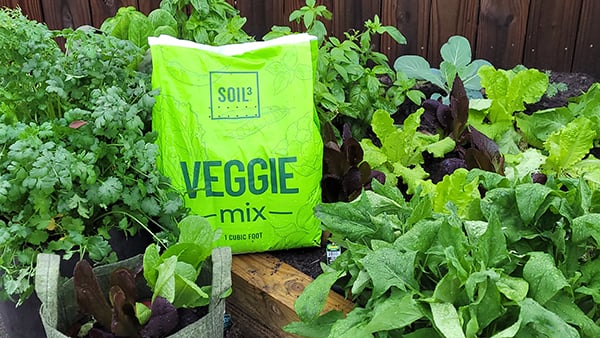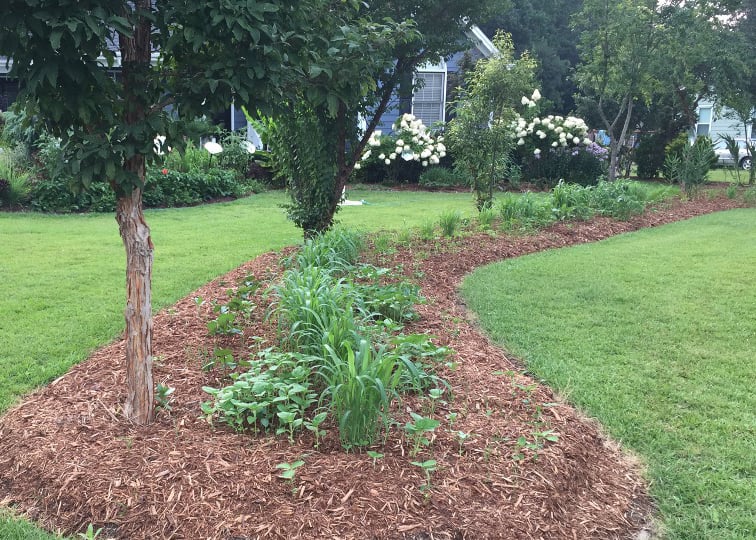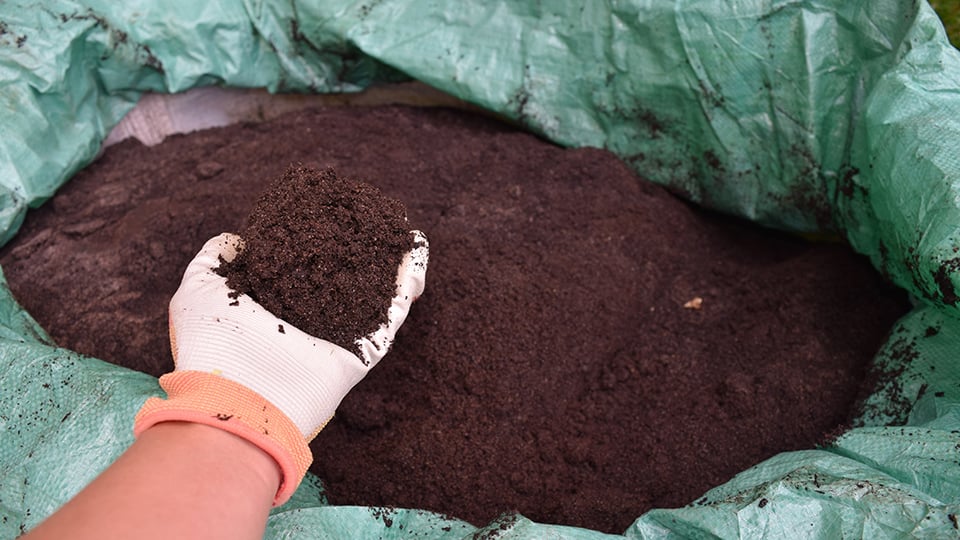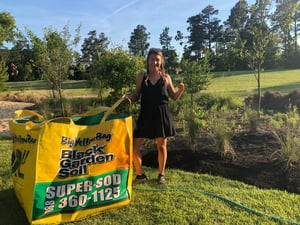Soil is the heart of successful gardening so gardeners across the world are asking the same thing: How can I fix my soil?
No matter where you live the ground is less than ideal, especially if you are living a new neighborhood.
Soil science is a complex conversation, and “fixing” the patch of earth you garden takes time and effort. The simplest solution is to add organic matter. No matter what type of soil you inherited, the addition of organic matter is the best way to improve it.
What is organic matter? Any carbon-based product that breaks down over time. Grass clippings, fallen leaves, mulch, and compost all count as organic matter. The more you add the faster you will have “dirt” that is easy to garden in.
The short answer to how to fix soil is quite easy: the best compost is the solution! (ahem, Soil³!) Want to learn more? Keep reading!
Test & Feed Your Soil
Southern gardeners face unique challenges with soil. Not only do we have difficult “native” conditions in the form of clay or sand, but we also have a mild winter climate. Since the ground does not freeze and we get a lot of rain in the cool season, much of the organic matter we have added gets used up faster. I always say the main hobby of a gardener is feeding the soil, and it is an aspect of growing that can’t be overlooked.
This is a subject that I am spending a lot of time researching as I develop a new ½ acre property. I want to avoid the many mistakes I made early on in my current garden and maximize my resources. The first step before taking any action is to get your soil tested. This is a service offered by state extension services and private companies and will provide a lot of necessary information to guide you on your journey to soil satisfaction.
Once you have your test results back you will have a better understanding of what kind of soil you are starting with. For most southern gardeners the challenges are similar for both clay and sand.
The goal is to develop a layer that is easy to cultivate, that retains moisture without staying too wet, and provides ample absorption of nutrients. Always remember, the roots grow in the air spaces between soil particles, which is why amending your soil with good compost is so imperative!
Past Land Use
You are not the first person to cultivate this spot of Earth. This is the reality of living in the 21st century. What we inherited is not natural land. Before you blame yourself, please consider what was happening on your property 50 years ago. For instance, I live in a former tobacco field, and because of 80+ years of growing the same crops year after year I now contend with disease and root knot nematode infestations. Those problems are here for me to face, but I didn’t cause them. So, give yourself a break and recognize past generations haven’t always been kind stewards to the land we are currently managing.
This is especially important for gardeners living in new neighborhoods where all the topsoil was removed before the houses were constructed. Think of all the heavy equipment that compacted the ground and, in many cases, all the trash that was buried under your foundation landscape. New developments are a nightmare because there has been no effort made to improve the soil and the homeowners are left to sort out a big mess. (I know this from experience!)
Gardening in Clay
There are some advantages that clay offers, including the ability to hold moisture and nutrients. Unfortunately, most clay soils are compacted and depleted, especially from recent construction activity.
Clay soil has very small pore spaces, which slow down the movement of water. In contrast, when conditions are dry, clay becomes hard (like a brick) which makes it difficult for air, water, earthworms, microbes, and roots to break through. I have never met anyone who declared they loved gardening in clay!
Gardening in Sand
Sand poses other complications, which I am well versed in, having gardened on the sandy side of Raleigh since 2005. At first glance sand seems great, as it is easy to dig in. However, because sand is made up of eroded pieces of rocks, the structure is less than ideal. Sandy soils have large particles that are solid and have no pockets for water and nutrients to attach to. This course texture leads to a dry root zone and high-water bills!
Best Practices for Long Term Soil Improvement
No matter what kind of soil you have, it likely needs to be improved for your garden to thrive.
Add Compost
As I mentioned, the addition of organic matter is the best approach for effectively amending and improving the ground long term. By applying thick layers of compost like Soil³ you can quickly create a space that is ready to be planted. This is by far the fastest way to fix the soil for immediate use.

Veggie Mix is 75% compost and 25% bark, with activated charcoal added.
Photo by Nestor Vela.
Leave the Leaves
The addition of ground leaves in the autumn is another ideal solution for adding organic matter that will decompose over the course of winter. It's in their name: LEAVE THE LEAVES!
I understand that leaves can look messy. Because of that I recommend mowing them, so they are shredded. Then top dress your beds as thick as you desire and add a light layer of mulch over top. You will never know the leaves are underneath doing their job improving your ground.

Mowing or dedicated leaf shredders help autumn leaves look less messy.
This shredder is by Worx. Photo by Hillary Thompson.
Mulch on Top
Mulch is another topic that must be addressed, as many natural mulches will also offer some soil improvement qualities. The finer the much texture the faster it breaks down, adding organic matter.
I prefer triple shred hardwood mulch and I apply a light layer (only 1-2”) twice a year when I am doing seasonal planting in June and December. It provides the aesthetic appeal while helping suppress weeds and holding in extra moisture, which is especially important through the heat of the summer.
It is important to note that fresh wood chips and sawdust are NOT IDEAL amendments because they will absorb all the nitrogen through their decomposition faze. Instead apply AGED materials. Pine needles are also not recommended unless lime is applied to counteract the acid conditions produced as the coniferous material breaks down.

Triple shredded mulch finished off my foodscape beds.
No Tiller Needed
Before you get too excited, put down that tiller! I know that used to be the standard practice - it is what I grew up doing - but we know more now about the importance of soil structure. Instead of working hard, work smart by layering organic matter on any open spaces in your landscape and garden and then sprinkle seeds over top to act as a green mulch.
Plant Cover Crops
This brings me to my favorite subject, cover cropping, which I dive into in my second book, Gardening with Grains. Farmers have been using this practice for years, but most home gardeners haven’t gotten the memo. Cover crops are an inexpensive and highly effective approach to naturally improving your soil.
There are three types of cover crops, all of which are ANNUAL plants, meaning they grow, flower, set seeds, and die in one season. In my experience, none of these plants have become invasive, and I now welcome the sight of self sowers knowing they are the hardest working plants in my garden!
Cover crops are used for improving soil health, slowing erosion, smothering weeds, increasing biodiversity, and nutrient acquisition. Most cover crops prefer full sun, though I have found many will grow in part sun condition of only 4 hours of direct light. They are easily grown by direct seeding into a fresh layer of Soil³.
The first class of cover crops are considered “Nutrient Scavengers.” This includes grain crops like barley, oats, rye, and wheat with deep root systems that draw nitrogen back up to the surface. These roots also act as a natural tiller, breaking through hardpan clay while ultimately adding organic matter to your soil.
“Nitrogen Fixers” are legume crops that work with bacteria to take nitrogen from the air and put it into the ground for plants to absorb. A few of my favorites include peanuts through the summer and peas in the winter.
Finally, there is the “Chop and Drop” category which includes beautiful plants such as buckwheat, crimson clover, mustard, and daikon radish. These plants release nutrients back into the soil after they have been cut down and allowed to decompose in place. We do this in nearly every bed in my garden and just use a push lawn mower to cut the plants back. It is a remarkably easy approach to soil improvement that also provides a gorgeous display!

Abby mowing daikon radish cover crop to add nutrients back to the soil.
Soil³ is Always the Solution
I have said it many times, but when I found Soil³ my life as a gardener was changed forever in the best possible way. This product truly does solve all the problems that we face for growing plants successfully.

When I first started using it, I added thick layers- 6-8” in some spots! But now, after several years of topdressing I find 2” annually is enough to revive my ground and provide all my plants need. I layer it right on top of the old mulch and then plant directly in it. Remember, every bit of organic matter will help improve your soil and make the growing experience beautiful and bountiful!
No matter what type of soil you are growing in, Soil³ is the solution. I am wishing you all the best in your gardening journey and hope you will tune in for updates as I break ground on the next-door property! I plan to take my own advice from this article so you can see it in action!
Happy gardening!
Brie
All photos by Brie Arthur, unless otherwise noted.



Did this help you out? Have any questions for clarity? Leave a comment below!